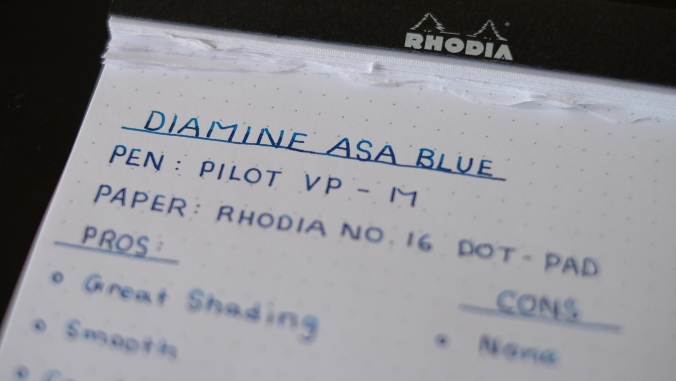Let’s kick off review week with a long pending ink review.
Originally not on my radar, as I was too obsessed with Noodler’s Liberty Elysium, Iroshizuku Kon-Peki and the many other blue inks out there. This one took a while to get my attention. I was initially introduced to it through a post by Ed Jelley (love his photography 🙂 ). The post was titled “5 Best Inks for Everyday Use”. Curious about his choices, I read through it, and the one that caught my eye was his photo of the shading of Diamine Asa Blue. It just called out to me through the screen, begging me to try it. Being the highly disciplined person I am with full control of my impulses, I immediately went and purchased a 30mL bottle and haven’t looked back since. I have gone through many a sample of blue inks, some I have loved, others not so much, but this… After I first used it, I felt like the search for my ideal blue ink was finally over.
While it may sound like hyperbole, I sincerely believe that I have finally found it. Diamine has been holding the hidden gem that I have been searching for all this time. If only a month ago, you had asked me what my favorite blue ink was, I would’ve unhesitatingly answered: “Iroshizuku Kon-Peki”, but now it would be “Diamine Asa Blue”. To me, Asa Blue is now the benchmark I will judge all the other blue inks I have yet to try. For me, Asa blue satisfies many requirements when it comes to color and performance, so I’ll be elucidating upon requirements shortly.

From the moment the nib touched the paper, I knew that this would most likely replace Kon-Peki as my favorite blue. The color and shading resembled Kon-Peki so much, yet at the same time, just glancing at it, Asa Blue seems much less resplendent. Kon-Peki, especially on the bright white Rhodia and Maruman paper I use it on, just glows brightly. Asa Blue on the other hand, tends to be much more subtle, yet still nice and visible. I first used it in my history class, which I had on Fridays for 4 hours (glad that’s over). Typically, it was a lecture only class with the professor talking and the students noting down the most salient points. The long time period allowed for the most experimentation and writing down notes for hours together helped me see how well it performs during long writing sessions. I was pleasantly surprised by how well it handled being in constant use. Despite the shrinking amount, the smoothness wasn’t affected in any way, and it continued to perform admirably.

The pen I first used Asa Blue in, was my Pilot VP Matte Black with the binderized M nib, which is still going strong. The Pilot VP is my everyday writing pen in school, it is the pen that has had the most use in my collection by far. Typically when testing inks, I like to load it up in the VP simply because the tuned nib ensures that it won’t be the nib’s fault if the ink doesn’t perform properly. After a 4 hour history lecture, when reviewing my notes before the quiz, I saw how wonderful each letter looked on the page. The color of the ink was exquisite, to say the least. It was then I knew that I had found my everyday blue ink.

The shading is one of the major things that drew me towards this ink. I love blues that get darker with bigger nibs, it allows for more experimentation and manipulation when writing. Asa Blue shades very well as seen in the picture above, and past a certain point, I got the hint of a red sheen.

Overall Asa Blue has been one of the best Diamine inks I have ever tried. The color and shading make for an excellent everyday blue that can walk the fine line between fun and whimsical, to serious and professional. It performed very well on the variety of papers I used to test it with little variation. After only a month, I polished off a 30mL bottle which in itself shows me how much I love this ink. All I can say is, if you love blue inks, you have to give this a try. Well, it’s time for me to go purchase some more and hope Diamine offers it in sizes larger than 80mL :P. Look forward to tomorrow’s review, and as always, write on, my friends.





















